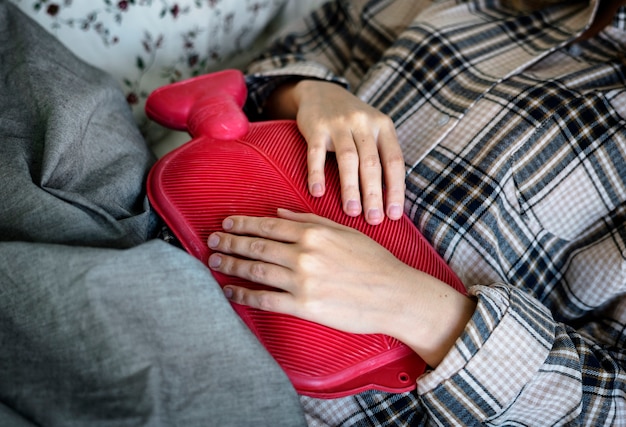
Menstrual cramps are a common issue that many women experience either a few days before their period starts or during the first few days of their cycle. While some women may not find them particularly bothersome, others deal with severe cramps that can disrupt their daily lives. Fortunately, there are several natural remedies to help ease this discomfort.
### Why Menstrual Cramps Happen
Cramps are a normal part of the menstrual cycle, caused by the uterus contracting to shed its lining. This can lead to discomfort in the lower abdomen, lower back, and thighs, which typically eases as the period progresses. Other symptoms that may accompany cramps include headaches, diarrhea, nausea, and vomiting. Interestingly, many women report little to no cramping after childbirth.
While the reasons why some women experience intense cramps are unclear, a few factors are associated with more severe menstrual pain:
– Starting menstruation at a young age
– Being under 20 years old
– Heavy blood flow
– A heightened sensitivity to or excess production of prostaglandins, which trigger uterine contractions
– Not having had children
– Conditions like endometriosis or uterine fibroids
– Using certain birth control methods
For mild to moderate cramps, natural remedies can provide relief and help you manage discomfort without the need for over-the-counter painkillers. If the pain is severe or persists, it’s important to consult a doctor to rule out underlying issues.
### Natural Remedies for Menstrual Cramps
#### 1. Heat Therapy
Applying heat to the lower abdomen can relax the uterine muscles and alleviate cramps. You can use a heating pad, hot water bottle, or heat patch to target the pain. Alternatively, soaking in a warm bath or sipping on a hot beverage can help soothe discomfort and promote relaxation.
#### 2. Gentle Exercise
Light physical activity, like stretching or walking, may seem difficult when you’re in pain, but it can be highly effective. Gentle exercise increases blood flow to the pelvic area and boosts the production of endorphins, your body’s natural painkillers. Regular physical activity, even outside of your period, can reduce the intensity of cramps over time.
#### 3. Massage
Massaging your lower abdomen with oil, such as coconut oil or essential oils, can help ease cramping. A simple 20-minute massage relaxes the pelvic muscles and provides relief. Essential oils such as clove, cinnamon, and lavender are particularly effective when blended with a carrier oil, like almond oil.
#### 4. Herbal Teas
Drinking warm herbal teas, like chamomile, fennel, or ginger tea, can soothe menstrual pain. Ginger, for example, has been shown to help reduce the production of prostaglandins, which are responsible for cramps. These teas can also help address other period symptoms, such as fatigue and irregular cycles.
#### 5. Fenugreek Seeds
Fenugreek seeds are known for their anti-inflammatory properties and can help ease cramps. Simply soak the seeds in water for 12 hours and drink the mixture for quick relief.
#### 6. Increase Magnesium Intake
Magnesium can help reduce muscle tension and ease cramping. Foods like spinach, yogurt, almonds, beans, and peanut butter are great sources of magnesium. Adding these to your diet or using magnesium supplements (under medical guidance) can help manage menstrual discomfort.
#### 7. Yoga
Practicing yoga can reduce the severity of menstrual cramps. Gentle poses like Shavasana and breathing exercises (Pranayama) help relax the body and improve overall well-being. However, avoid inverted poses during your period, as they can disrupt menstrual flow.
#### 8. Alternative Therapies
– **Acupuncture:** This technique involves inserting thin needles into specific points on the body to release endorphins and reduce inflammation, relaxing the uterine muscle.
– **Acupressure:** Applying gentle pressure to specific points on the body can provide pain relief. While there’s limited research on its effectiveness, many find it helpful.
#### 9. Dietary Supplements and Herbal Remedies
Adding supplements like Vitamin B-1, B-6, Vitamin E, magnesium, or omega-3 fatty acids can ease cramps by targeting inflammation and muscle contractions. Herbal remedies like fennel or pycnogenol (pine bark extract) are also believed to provide relief, but consult with a healthcare provider before trying these treatments.
#### Transcutaneous Electrical Nerve Stimulation (TENS)
TENS involves using a device with electrodes to send small electrical pulses to the skin, which can block pain signals and stimulate endorphin production. Studies suggest TENS can help reduce menstrual pain significantly.
### Conclusion
Menstrual cramps can disrupt your daily life, but with the right natural remedies, you can manage this pain effectively. From heat therapy and herbal teas to light exercise and yoga, there are plenty of options to explore. Try incorporating these remedies into your routine and consult a doctor if your cramps are severe or persistent. With consistent care, your period days can become much more manageable.